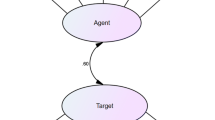Abstract
Comprehensive, reliable, and valid measurement of prejudicial attitudes and behaviors toward lesbians and gay males has been identified as a priority. A sample of undergraduate (N=97) and high school students (N=40) completed three reliable measures of cognitive (Modified Attitudes Toward Homosexuality Scale), affective (Affective Reactions to Homosexuality Scale), and behavioral (Homophobic Behavior of Students Scale) reactions to homosexuals. Undergraduate students' responses confirmed the three-factor structure (homophobic guilt, homophobic anger, delight) of affects in this domain, and supported the concurrent validity of the behavioral measure. Predictive validity of the behavioral scale was demonstrated by findings of the high school study which showed that students subsequently acted in accordance with their responses to this paper-and-pencil test. LISREL confirmatory factor analysis of the overarching model indicated that a tripartite (cognition-affectbehavior) measurement strategy was appropriate. This strategy may be used in future research to provide comprehensive indication of which educational interventions make a difference in improving understanding and acceptance of homosexuality.
Similar content being viewed by others
References
Berrill, K. T. (1990). Anti-gay violence and victimization in the United States: An overviewJ. Interpers. Violence 5: 274–294.
Bhugra, D. (1987). Homophobia: A review of the literature.Sex. Marital Ther. 2: 169–177.
Britton, D. M. (1990). Homophobia and homosociality: An analysis of boundary maintenance.Sociol. Quart. 31: 423–439.
Byrne, B. M. (1989).A Primer of LISREL: Basic Applications and Programming for Confirmatory Factor Analysis Models, Springer-Verlag, New York.
Buhrke, R. A., Ben-Ezra, L. A., Hurley, M. E., and Ruprecht, L. J. (1992). Content analysis and methodological critique of articles concerning lesbian and gay male issues in counseling journals.J. Counsel. Psychol. 39: 91–99.
Clift, S. M. (1988): Lesbian and gay issues in education: A study of the attitudes of first year students in a college of higher education.Br. Educ. Res. J. 14: 31–50.
Croteau, J. M., and Kusek, M. T. (1992). Gay and lesbian speaker panels: Implementation and research.J. Counsel. Dev. 70: 396–401.
Eagly, A., and Chaiken, S. (1993).The Psychologyof Attitudes, Harcourt Brace Jovanovich, New York.
Ernulf, K. E., and Innala, S. M. (1987). The relationship between affective and cognitive components of homophobic reaction.Arch. Sex. Behav. 16: 501–509.
Gay and Lesbian Rights Lobby. (1990).Streetwatch Report, Gay and Lesbian Rights Lobby, Sydney.
Gay and Lesbian Rights Lobby. (1992).Off Our Backs Report: A Study into Anti-Lesbian Violence, Gay and Lesbian Rights Lobby, Sydney.
Harry, J. (1990). Conceptualizing anti-gay violence.J. Interpers. Violence 5: 350–358.
Herek, G. M. (1984). Attitudes toward lesbians and gay men: A factor-analytic study.J. Homosex. 10: 39–51.
Herek, G. M. (1986). On heterosexual masculinity: Some psychical consequences of social construction of gender and sexuality.Am. Behav. Sci 29: 563–577.
Herek, G. M. (1990). The context of anti-gay violence: Notes on cultural and psychological heterosexism.J. Interpers. Violence 5: 316–333.
Herek, G. M., and Berrill, K. T. (1990). Anti-gay violence and mental health: Setting an agenda for research.J. Interpers. Violence 5: 414–423.
Holtzen, D. W., and Agresti, A. A. (1990). Parental responses to gay and lesbian children: Differences in homophobia, self-esteem, and sex-role stereotypes.J. Soc. Clin. Psychol. 9: 390–399.
Hu, L. Bentler, P. M., and Kano, V. (1992). Can test statistics in covariance structure analysis be trusted?Psychol. Bull. 112: 351–362.
Innala, S. M., and Ernulf, K. E. (1992).The Relationship Between Affective and Cognitive Components of Homophobic Reaction: Three Cross-National Replications, Göteborg Psychological Reports, Vol. 22, No. 2, Department of Psychology, University of Göteborg, Sweden.
Jöreskog, K., and Sörbom, D. (1989).LISREL 7: User's Reference Guide, Scientific Software, Mooresville, IN.
Kite, M. E., and Deaux, K. (1986). Attitudes toward homosexuality: Assessment and behavioral consequences.Basic Appl. Soc. Psychol. 7: 137–162.
Kurdek, L. A. (1988). Correlates of negative attitudes toward homosexuals in heterosexual college students.Sex Roles 18: 727–738.
Lance, L. M. (1987). The effects of interaction with gay persons on attitudes toward homosexuality.Hum. Rel 40: 329–336.
Larsen, K. S., Reed, M., and Hoffman, S. (1980). Attitudes of heterosexuals toward homosexuality: A Likert type scale and construct validity.J. Sex Res. 16: 245–257.
Loehlin, J. C. (1987).Latent Variable Models: An Introduction to Factor, Path, and Structural Analysis, Erlbaum, Hillsdale, NJ.
Long, J. S. (1983).Confirmatory Factor Analysis: A Preface to LISREL, Sage, Beverly Hills, CA.
Morin, S. F., and Garfinkle, E. M. (1978). Male homophobia.J. Soc. Issues 34: 29–47.
Plasek, J. W., and Allard, J. A. (1984). Misconceptions of homophobiaJ. Homosex. 10: 23–37.
Price, J. H. (1982). High school students' attitudes toward homosexuality,J. School Health 52: 469–474.
Stevenson, M. R. (1988). Promoting tolerance of homosexuality: An evaluation of intervention strategies.J. Sex. Res. 25: 500–511.
Van de Ven, P. (1994).Challenging homophobia in schools. Unpublished doctoral thesis, University of Sydney.
Van de Ven, P. (1995). Effects on high school students of a teaching module for reducing homophobia.Basic Appl. Soc. Psychol. 17: 153–172.
Weinberg, G. (1972).Society and the Health Homosexual, Doubleday, New York.
Weitz, R. (1982). From the closet to the classroom: Homosexuality in abnormal psychology and sociology of deviance textbooks.Deviant behav. 3: 385–398.
Author information
Authors and Affiliations
Rights and permissions
About this article
Cite this article
Van de Ven, P., Bornholt, L. & Bailey, M. Measuring cognitive, affective, and behavioral components of homophobic reaction. Arch Sex Behav 25, 155–179 (1996). https://doi.org/10.1007/BF02437934
Issue Date:
DOI: https://doi.org/10.1007/BF02437934




